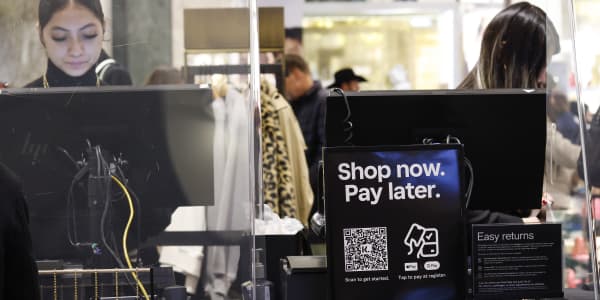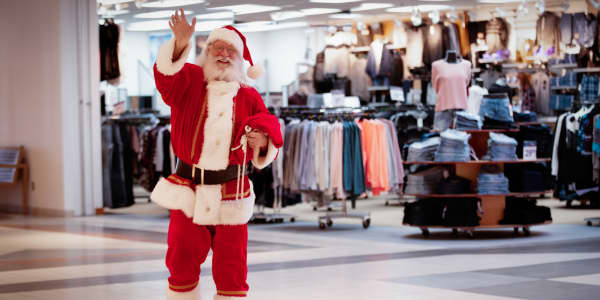After a year of sluggish demand and never-ending promotions, things may finally be turning a corner in the retail industry.
In the first of many holiday retail sales forecasts to be released over the next few weeks, Deloitte on Wednesday predicted the improving overall economy will translate into a retail sales increase between 4 percent and 4.5 percent from November through January.
That represents a modest improvement over last year's 2.8 percent gain to $944 billion, according to U.S. Commerce Department data that excludes auto and gasoline sales.
Still, experts predict the season will once again be riddled with discounts that come early and often, as retailers compete for shoppers' dollars.
"We're really optimistic and there are a few reasons for that," said Alison Paul, vice chairman and U.S. retail and distribution leader at Deloitte. "There are some good economic fundamentals in place this year that weren't as strong last year."
Read MoreRetail's turnover: Plus for the economy, challenge for stores
Among them: Income, wage and job growth are all trending positive; debt levels are at historic lows; and stock market gains and rising home prices may boost spending, the firm said. Paul also pointed to lower gas prices which, at a national average of about $3.34 a gallon, are approximately 15 cents cheaper per gallon than one year ago, according to GasBuddy.com.
These factors should give a boost to both gift buying and self-purchasing, bringing back the "one for you, one for me" mentality—an important factor in posting robust holiday growth of 3 percent or greater, Paul said.
"That was what was lost the last two years to the holidays, was the 'me too' gift buying," she said. "There's a little bit more chance of that impulse buy."
Read MoreWal-Mart says this is what the kids want for Christmas
Deloitte factors January spending into its forecast to account for gift card redemptions and other holiday-related purchases that are made after Christmas. According to research by Stitch Labs, a software provider for retailers and wholesalers, January 2014 raked in 152 percent more sales than the pre-holiday rush in October 2013.
Not a home run yet
Deloitte's forecast comes one week after Challenger, Gray & Christmas said retailers could add 800,000 seasonal workers this holiday for the first time since 1999. The outplacement firm also said holiday spending will "undoubtedly" benefit from payrolls increasing an average of 215,000 new workers each month.
Read MoreMerry Christmas! Holiday hiring may hit dot-com boom level
Separately, management consulting firm Hay Group's annual study found 70 percent of retailers expect sales will be on par with last year, while 24 percent expect an increase of 5 percent or more compared with 2013.
It also follows a series of weekly same-store sales gains reported by the International Council of Shopping Centers, which indicate the back-to-school selling period was strong.
"If we had run this survey in June, I think we would have gotten a different answer," said Craig Rowley, vice president and global practice leader for Hay Group's retail practice.
Read MoreKMart's first Christmas ad? You decide
That's not to say everyone thinks Christmas will be a home run. Although there are a number of tailwinds that should benefit retailers this holiday—including trimmed down inventories, easy comparisons to the previous year, and positive comments on back-to-school sales during their most recent earnings calls—there are also plenty of reasons to remain cautious, Wells Fargo analyst Paul Lejuez said.
There's a chance that an unseasonably cool summer brought back-to-school shoppers out earlier, pulling sales forward; the potential for the new iPhone 6 and 6 Plus to steal wallet share; and Gap's early promotions, which could spark a chain reaction.
"It isn't like the mall hasn't been promotional for the past several years, but against the backdrop of inventories being in better shape in general… it is concerning to hear about promotions kicking up further," Lejuez said. "By our account, Gap brand is the second-largest specialty apparel retailer in the U.S. [behind Old Navy], so deeper promotions can have an impact on others."
In its forecast, Hay Group voiced a similar concern surrounding promotions, saying it expects most retailers to begin discounting in September or October, compared with the October to November starts that are typical.
By doing so, they not only have a chance to beat out competitors for shoppers' dollars—they also stand to gain from consumers adding more items to their lists as the months go by.

"If I get you to shop sooner the odds of you increasing your budget are higher," Rowley said.
Retail expert Robin Lewis, author of The Robin Report online newsletter, offered a substantially grimmer outlook—he predicts there will be zero percent growth this holiday, which will in turn spark "share wars." This type of competition could once again be detrimental to retailers' margins, which took a beating in 2013 as stores tried to one-up each other on price.
"With coupons, discounts, loyalty points and gifts-with-purchase more the rule that the exception today, consumers are spending less because they can," Lewis said.
As was the case in 2013, online sales are expected to see exponential growth this holiday, according to Deloitte. The firm predicts digital interactions will influence 50 percent, or $345 billion, of in-store sales this holiday, with non-store sales rising 13.5 percent to 14 percent to account for about $122 billion.
Along these lines, perhaps the biggest change to the narrative this year, Paul said, is that traditional retailers are starting to catch up to their online-only competitors. She predicts online retailers will post solid holiday numbers, as will the bricks-and-mortar players who have beefed up their websites, mobile apps and tablet capabilities.
"Online has demonstrated month-on-month double-digit growth and I don't see that trend changing," she said.






